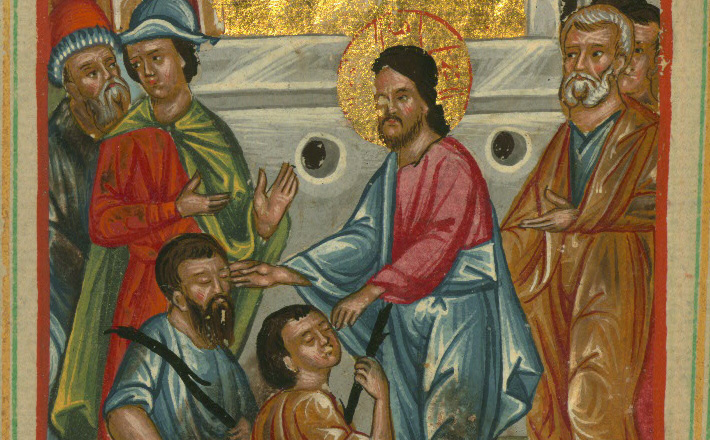Commentary on John 9:1-41
This text offers at least three or four related trajectories of interpretation:
- the question of human suffering;
- the absence of Jesus in verses 8 through 34, the longest absence of Jesus in the gospel1;
- the incremental growth of the blind man’s testimony (12, 17, 33, 38); and
- the irony of “seeing” and yet remaining blind and how a confession of, “I don’t know” may open our eyes to deeper wisdom.
According to Gail R. O’Day, this text resembles a Greek play. In this dramatic genre, each scene had no more than two characters speaking.2 The first three “scenes” might look like this:
Scene 1: John 9:1-5
Disciples and Jesus. Who sinned, thus leading to his blindness, this man or his parents? Jesus announces that, “I am the light of the world.” Exit Disciples.
Scene 2: John 9:6-7a
Enter Blind man. Jesus speaks to the man, applies “mud made with saliva” over his eyes and tells him to go wash in the pool of Siloam. Exit Jesus.
Scene 3: John 9:8-12
Enter Village/Neighbors. When asked “how” his eyes were opened, he tells what “the man called Jesus did” (verse 11). Those who had known the blind man, now do not know him or are uncertain that this is the same person. While they “saw” him clearly as the blind man they could not “see” him as sighted. All the while he says, “I am the man.” When asked “where” this man (“the light of the world”) is, he replies, “I do not know” (verse 12).
Using the text’s dramatic structure may help interpreters isolate a particular question or problem as it develops in each discrete scene. Whatever strategy employed, we should keep the beginning of this text in sight, namely, the question of the disciples: “Who sinned, this man or his parents?”
Significantly, the disciples take blindness for granted. It is a terminus, an end point in itself, the cause of his blindness being the only thing of interest to the disciples. This man amounts to his diagnosis, only. Yet, with Jesus, our diagnosis does not have the last word, as this text will go on to demonstrate.
Undermining the power of fears and prejudice is often easier said than done. Often it requires an indirect approach. For example, while teaching a poetry class to a group of children, ages 8 to 13, we experimented with acrostic poems. Asked what kind of food they disliked, one boy answered, “Octopus” — and we had our word and especially, perhaps, his distaste for seafood. And we all had a giggle.
However, as we worked through the different letters of the acrostic, the children in the class “helped” us to see this mysterious creature more richly, from its suction cups, to its ability to squeeze through small holes, to its association with other strange and mysterious creatures, such as the platypus, and even our fears, as one girl wrote for “S”: “Staring eyes looking straight at you!” In other words, at first, we had “seen” our distaste or perhaps our deepest fears — through the medium of acrostic our “sight” deepened into something like insight.
The challenge of this text will be to frame the sermon in such a way that the congregation participates in the deconstruction of commonly held views or opinions about the human condition — views that may be reinforced by deep-seated fears.
One topic of conversation might surface quickly in such an exercise, namely the question of human suffering. In John’s gospel, the characters have arrived at seemingly different explanations for his blindness: either he sinned or his parents sinned.
According to biblical scholar, Gerard S. Sloyan, the disciples debate the question of whose sin produced this suffering; they do not debate whether the presupposition behind this (that seeing suffering we can conclude sin) is valid; nor do they question whether suffering may, in fact, be anything more than a terminal diagnosis.3
Most listeners today will reject the sort of reasoning present among the disciples who, seeing suffering, conclude sin. We’re more sophisticated in this regard since we would probably look for physiological reasons. However, it is not at all unusual for us to fall into the trap of reductive explanations for suffering.
For example, we often hear the debate about whether personal troubles are attributable to nature or nurture. That’s a pretty well-established battle line but does it really help us navigate human suffering and what it means from the vantage point of God’s love for the world?
Sloyan believes that John writes neither about a flawless universe nor one “shot-through with miracle” but instead about a God who has sent his Son Jesus and “rendered deity” knowable through Christ’s love.4
While preachers should indicate that God does not make an instrument out of suffering, making it somehow necessary, John’s gospel does point to a God who stirs the stagnant determinisms of human suffering with unlikely and improbable gifts of insight which reveal God’s abiding love.
Michele M. Bilyeu is a textile artist in Salem, Oregon, who uses her medium to undermine our understanding of those who suffer with Alzheimer’s Disease. She entitles one piece, Mama’s Brain’s Got Tangles…But Mama’s Still Inside: “Like my mother’s memory, this art quilt consists of many layers, tangles, and threads…with spots of clarity and light hidden amidst the colorful (but often chaotic) surface layer.”5
That “surface layer” seemed to define the blind man for the surrounding community. To be sure, the blind man lived in a community, but it is striking how little his neighbors knew about him or even of him. They saw mostly his condition. And yet when he says, “I am the man” it seems they only hear their own doubts, their own circumscribed realities.
Interestingly, his words echo Jesus’ “I am” statements; even more suggestive, one may hear echoes of Jesus’ words about himself in John 8: 40a: “Now you are trying to kill me, a man who has told you the truth…”
Jesus discloses his identity as the Son of Man to the blind man: “‘You have seen him and the one speaking with you now is he’” (9:35).
While it may be implied by 7b (“he came back able to see”), the blind man had not “seen” Jesus until the end of this chapter, suggesting that Jesus doubles the meaning of the verb, “to see” in this text, recalling both physical sight and inward illumination.
Bilyeu seems to grasp the Johannine notion of “double illumination” when she offers the Alzheimer’s Prayer: “I pray that [caregivers and family members will care] for their patients and loved ones as the people they truly are . . . and not just who they seem to have become.”6
Notes:
1 Gail R. O’Day, “John” in The New Interpreter’s Bible, Vol. 9: Luke John, ed. Leander E. Keck, et. al. (Nashville: Abingdon Press, 1995), 651.
2 Ibid., 651.
3 Gerard S. Sloyan, John, ed. James Luther Mays, et. al. (Atlanta: John Knox Press, 1988), 115.
4 Ibid., 122.
5 Michele Bilyeu, “With Heart and Hands” (25 September 2012), http://www.with-heart-and-hands.com/2012_09_01_archive.html, accessed on 16 November 2013.
6 Ibid.


March 30, 2014